BRECHTEL 4001-115V User manual

Particle into Liquid Sampler (PILS)
Instrument Manual Ver. 3.0
Models 4001-115V and 4001-230V
with PILS-AC80 and PILS-AC38 Auto Collector
For BMI-PILS 4001 v1.0.vi software and BMI-Auto Collector v1.1.vi software
BMI PN: 83-00009-01A
June 6, 2022

CONTENTS
Contents
1 Caution 5
1.1 Indoor use .................................. 6
1.2 Max operating temperature ....................... 6
1.3 Rack-mounting ................................ 6
1.4 Pinch hazard ................................. 6
1.5 Needle puncture hazard .......................... 6
1.6 Burn hazard ................................. 6
1.7 Electrical shock hazard ........................... 7
1.8 Water leak hazard .............................. 7
1.9 Replaceable fuses .............................. 7
1.10 Power cord .................................. 7
1.11 Shock during shipping ........................... 7
1.12 Freezing during shipping ......................... 8
1.13 Accessories .................................. 8
1.14 Lifting and carrying ............................. 8
1.15 No User serviceable parts ......................... 8
1.16 EMI statement (Class A) .......................... 8
2 Changes 10
3 Declaration of Conformity 11
4 Contact BRECHTEL 13
4.1 Getting Help ................................. 13
83-00009-01A PILS 4001-115V and 4001-230V Page 1 of 74

CONTENTS
5 Unboxing 14
5.1 Before First Use ............................... 14
6 PILS Overview 15
6.1 Description .................................. 15
6.2 Theory of Operation ............................ 16
Chemical Sampling Eciency of the PILS .............. 18
6.3 PILS Chassis ................................. 19
Steam Generator System ........................ 20
Peristaltic Pump .............................. 20
Temperature Controllers ........................ 24
Condensation Chamber, Droplet Impactor and Debubbler ... 25
6.4 Liquid Supply and Drain Bottles ..................... 27
6.5 Sample Air Flow Control System ..................... 29
6.6 PILS On-line Analysis ............................ 29
Ion Chromatography Systems ..................... 29
Water Soluble Organic Carbon Monitors .............. 30
6.7 Auto-collector ................................ 30
Auto-collector Software ......................... 33
6.8 Pre-Impactor ................................. 33
6.9 Vapor Denuders ............................... 33
6.10 PILS Options ................................. 34
6.11 PILS Specications ............................. 36
6.12 Shipping the PILS .............................. 37
7 System Setup 39
7.1 Packing List .................................. 39
83-00009-01A PILS 4001-115V and 4001-230V Page 2 of 74

CONTENTS
7.2 Assembly ................................... 39
7.3 Tubing Connections ............................ 41
Peristaltic Pump .............................. 41
Vacuum Pump ............................... 42
Sample Flow ................................ 42
Auto-collector ............................... 42
Pre-Impactor ................................ 44
Vapor Denuders ............................. 44
7.4 Electrical Connections ........................... 45
7.5 Computer Connections .......................... 45
7.6 Software ................................... 46
7.7 Rack Mounting ................................ 47
8 Operating the PILS 49
8.1 PILS Operating Procedures ........................ 49
8.2 BMI PILS 4001 v1.0.exe program ..................... 50
8.3 Description of PILS output le ...................... 52
8.4 Auto-collector operating procedures .................. 53
Auto-collector Software ......................... 53
Description of Auto-collector output le ............... 59
8.5 Pre-Impactor ................................. 59
8.6 Vapor Denuders ............................... 60
9 Maintenance 61
9.1 Mesh Wick .................................. 61
9.2 Peristaltic Pump Tubing .......................... 61
9.3 Liquid Flow Rate ............................... 62
83-00009-01A PILS 4001-115V and 4001-230V Page 3 of 74

CONTENTS
9.4 O-rings .................................... 63
9.5 Cleaning the PILS .............................. 63
9.6 Bottles ..................................... 63
9.7 Peristaltic Pump ............................... 63
9.8 Fuses ...................................... 64
9.9 Inorganic Denuder Rejuvenation ..................... 64
9.10 Organic Denuder Rejuvenation ..................... 65
9.11 Wick Replacement ............................. 66
9.12 Droplet Impactor Removal ........................ 68
9.13 Steam Generator Removal ........................ 70
10 PILS Errors 72
11 Troubleshooting 73
83-00009-01A PILS 4001-115V and 4001-230V Page 4 of 74

1 Caution
1 Caution
Read this section before operating the device. The operating conditions listed below can
be hazardous to you and/or your product.
Symbol Description
Indicates a Warning or Hazard requiring further explanation than a
label on the device can provide. Consult the user’s manual for more
information.
Indicates a hot surface.
Indicates hazardous voltages.
Indicates earth (ground) terminal.
Indicates electrostatic discharge hazard.
Indicates that you must not discard this electrical/electronic prod-
uct in domestic household waste.
Indicates blowing steam hazard.
Indicates steam energy hazard.
83-00009-01A PILS 4001-115V and 4001-230V Page 5 of 74

1.1 Indoor use
1.1 Indoor use
The model 4001, PILS-AC80, and PILS-AC38 are intended for indoor use only. The op-
erating temperature range of the devices is 0-40C. The operating humidity range of the
devices is 10-95%.
1.2 Maximum recommended operating ambient temperature
The maximum recommended operating ambient temperature is 40C.
1.3 Rack-mounting
Only use the hardware and rack-mount ears supplied by the factory to mount the product
in a rack.
1.4 Pinch hazard
Do not operate the product with any of the white plastic tubing clamps removed from
the peristaltic pump as a pinch hazard may result if a nger, foreign object, or other
item becomes lodged between the rollers of the pump.
1.5 Needle puncture hazard
Do not operate the Auto-Collector product with the needle guards removed from the
needle housing as a puncture hazard may result if a nger, foreign object, or other item
becomes lodged between the needle housing and vial carousel or under the needle as it
inserts into a vial.
Do not insert a nger, foreign object, or any other item under the needle housing.
1.6 Burn hazard
Removing the chassis cover may expose you to items at high temperatures that
could burn you. Only trained service personnel should remove the chassis cover. In par-
83-00009-01A PILS 4001-115V and 4001-230V Page 6 of 74

1.7 Electrical shock hazard
ticular, if the insulation on the steam delivery tube between the steam heater and the
steam injector is removed, the exposed metal surfaces will be hot during operation.
1.7 Electrical shock hazard
Removing the chassis cover may expose you to high AC voltage circuits that can
harm you if touched. Only trained service personnel should remove the chassis cover.
1.8 Water leak hazard
Improperly connecting the liquid supply or drain bottle tubes to the peristaltic pump
may result in a water leak. Improperly connecting the liquid supply tube from the peri-
staltic pump to the Auto-collector may result in a water leak. Blockage of the steam
tip or steam heater coil tubes may result in back pressure producing a water leak in the
steam heater liquid supply line. Take care to locate devices so a water leak near the front
of the PILS chassis or the rear panel of the Auto-collector does not create a hazardous
condition.
1.9 Replaceable fuses
Only replace AC power fuses with ”H” style fuses having identical size, voltage, and cur-
rent carrying capacity. The internal 24 VDC fuse may only be replaced by trained service
personnel.
1.10 Power cord
Caution: Only use the power cord provided with the Model 4001 PILS. Risk of re if used
with a power cord which has an inadequate rating. Contact Brechtel for a replacement
cord if the power cord is damaged or missing.
1.11 Shock during shipping
If the shock watch installed on the shipping case has tripped, contact BRECHTEL. Vi-
sually inspect the PILS to check for any components that may have come loose during
shipping.
83-00009-01A PILS 4001-115V and 4001-230V Page 7 of 74

1.12 Freezing during shipping
1.12 Freezing during shipping
Components in the PILS may be damaged when exposed to freezing temperatures during
shipping. Be sure to dry out the device prior to shipment.
1.13 Accessories
Only accessories approved by BRECHTEL and meeting required factory specications
may be used with the device.
1.14 Lifting and carrying
The PILS and Auto-collector shipping boxes are large and moderately heavy. Take care
to lift and carry the boxed devices, as well as the devices themselves, to avoid injury.
1.15 No User serviceable parts
WARNING: There are no user serviceable parts within the device. Removal
of the PILS control chassis top cover may expose the user to high voltages, high tem-
peratures, and pressurized steam. Only trained service personnel should remove the
chassis cover. Removal of the top cover by anyone other than a trained service per-
sonnel will void the product warranty.
1.16 EMI statement (Class A)
US:
NOTE: This equipment has been tested and found to comply with the limits for a Class A
digital device, pursuant to part 15 of the FCC Rules. These limits are designed to provide
reasonable protection against harmful interference when the equipment is operated in
a commercial environment. This equipment generates, uses, and can radiate radio fre-
quency energy and, if not installed and used in accordance with the instruction manual,
may cause harmful interference to radio communications. Operation of this equipment
in a residential area is likely to cause harmful interference in which case the user will be
required to correct the interference at his own expense.
CANADA:
83-00009-01A PILS 4001-115V and 4001-230V Page 8 of 74

1.16 EMI statement (Class A)
This Class A digital apparatus complies with Canadian ICES-003. Cet appareil numérique
de la classe A est conforme à la norme NMB- 003 du Canada.
83-00009-01A PILS 4001-115V and 4001-230V Page 9 of 74

2 Changes
2 Changes
Change Description Page Date Author
v2.0 Update commands N/A 5/24/2018 FJB
v3.0 Update software discussion; cau-
tions updates; add certications
Various 6/6/2022 FJB
83-00009-01A PILS 4001-115V and 4001-230V Page 10 of 74

3 Declaration of Conformity
3 Declaration of Conformity
Name: Particle Into Liquid Sampler
Regulatory Model Number: 4001-115V, 4001-230V
Environmental Conditions: Pollution Degree 2, Installation Category II, Equipment Class
1. This equipment requires the following space for ventilation, maintenance access, and
easy access to the Main Power Switch. There must be clear space of at least 30 cm (12”)
on all sides of the equipment. The bench in your laboratory must be able to support the
entire system and other laboratory equipment.
Conforms to the following safety standards:
Canadian Standards Association (CSA) C22.2 No. 61010-1
Nationally Recognized Test Laboratory (NRTL): ANSI/UL 61010-1
International Electrotechnical Commission (IEC): 61010-1, 61010-2-010, 61010-2-081
EuroNorm (EN): 61010-1
Conforms to the following regulations on Electromagnetic Compatibility (EMC) and Ra-
dio Frequency Interference (RFI):
CISPR 11/EN 55011: This is a Class A product. In a domestic environment this product
may cause radio interference in which case the user may be required to take adequate
measures.
IEC/EN 61326-1
AS/NZS CISPR11
US:
NOTE: This equipment has been tested and found to comply with the limits for a Class A
digital device, pursuant to part 15 of the FCC Rules. These limits are designed to provide
reasonable protection against harmful interference when the equipment is operated in
a commercial environment. This equipment generates, uses, and can radiate radio fre-
quency energy and, if not installed and used in accordance with the instruction manual,
may cause harmful interference to radio communications. Operation of this equipment
83-00009-01A PILS 4001-115V and 4001-230V Page 11 of 74

3 Declaration of Conformity
in a residential area is likely to cause harmful interference in which case the user will be
required to correct the interference at his own expense.
CANADA:
This Class A digital apparatus complies with Canadian ICES-003. Cet appareil numérique
de la classe A est conforme à la norme NMB- 003 du Canada.
This product complies with the EU RoHS Directive 2011/65/EU, and conforms to EN 50581.
83-00009-01A PILS 4001-115V and 4001-230V Page 12 of 74

4 Contact BRECHTEL
4 Contact BRECHTEL
4.1 Getting Help
Contact BRECHTEL for any questions or assistance with this product. Include the model and
serial numbers when
contacting Brechtel.
Brechtel Manufacturing Incorporated
1789 Addison Way
Hayward, California 94544, USA
Telephone: (510) 732-9723
Fax: (510) 732-9153
Email: [email protected]
83-00009-01A PILS 4001-115V and 4001-230V Page 13 of 74

5 Unboxing
5 Unboxing
Each BRECHTEL PILS is inspected and tested in-house at BRECHTEL to ensure out of
the box operation upon delivery. Prior to opening, inspect the packaging container and
ShockWatch impact indicators.
Carefully open the package and inspect the instrument and any accessories for broken
parts, scratches, dents or other signs of damage incurred during shipping. Notify BMI
within 2 days of receiving the package if the shock indicator (Fig 1) has activated or of
any other visible damage.
Retain all shipping
packaging, foam inserts
and cushions to ensure a
safe delivery should the
instrument need to be
returned.
Notify BMI within 2 days of receiving your product if the shock indicator has activated
and/or there is any other visible damage.
Verify the contents of the shipment using the information provided in this manual.
Figure 1: The black
arrows on the shock-
watch indicate the
package experienced
excessive shock dur-
ing shipping. Red ar-
rows indicate no shock
above the G level indi-
cated.
5.1 Before First Use
WARNING: The foam shipping blocks under the Auto-collector carousel must
be removed before operation. Take care not to damage the optical sensors under the
carousel while removing the foam.
83-00009-01A PILS 4001-115V and 4001-230V Page 14 of 74

6 PILS Overview
6 PILS Overview
6.1 Description
The Particle into Liquid Sampler (PILS) is used to measure the chemical composition
of water-soluble components of the ambient aerosol. Brechtel has integrated the PILS
droplet impactor and steam generator systems into a complete aerosol sampling system
that can be operated autonomously. The PILS has been extensively tested and a sum-
mary of the tests and historical eld data may be found in the paper by Sorooshian et al.,
2006, Aerosol Science & Technology, 40: 396-409 and other references. The PILS can
be directly connected to a user-supplied Ion Chromatography (IC) system, Total Organic
Carbon (TOC) analyzer, an Optical Waveguide, or other analytical systems to provide on-
line composition measurements. Alternatively, the Auto-collector produced by Brechtel
may be used with the PILS to allow liquid sample collection into vials.
Figure 2: Photo of the PILS.
Shown with Auto-collector
and PC.
The major components of the complete PILS system are shown in gure 2 and include:
1. a steam generation system to produce and inject steam into the condensation
chamber,
2. the condensation chamber and droplet impactor for growing sampled particles
into collectable droplets and collecting them on the quartz impactor plate,
3. a peristaltic pump to supply liquid to the steam generator, provide the impactor
washow and liquid sample ow, and handle waste liquid,
4. a debubbler to remove air from the liquid sample ow,
5. a critical orice to maintain constant sample air ow,
83-00009-01A PILS 4001-115V and 4001-230V Page 15 of 74

6.2 Theory of Operation
6. a temperature controller to control the steam heater temperature and a tem-
perature monitor to measure the steam injection tip temperature,
7. instrument software loaded on a user-supplied Windows computer to record
the steam heater and steam injector tip temperatures.
6.2 Theory of Operation
The purpose of the PILS is to grow sub-micrometer aerosol into 2 to 3 micrometer di-
ameter water droplets so the grown droplets can be collected for chemical analysis. All
particles larger than 0.03 micrometer within the air sample ow entering the PILS are
grown into collectable drops, irrespective of their chemical composition. For example,
even non-hygroscopic soot aerosol are grown to large droplets that are collected. How-
ever, non-water soluble species are not sampled quantitatively as they are deposited
and lost to the quartz impactor disk, mesh wick, and other surfaces before arriving at
the point of analysis or a vial.
A schematic of the PILS is shown in Fig. 3. The sample air ow is shown with black
arrows. The droplet impactor washow lines are shown with red arrows, while liquid
sample out ow lines are shown with open blue arrows. The steam liquid ow to the
steam generator is shown with open blue arrows. Waste liquid ows are shown as black
lled/blue arrows.
83-00009-01A PILS 4001-115V and 4001-230V Page 16 of 74

6.2 Theory of Operation
PILS head
Critical
Orifice
PILS
Inlet
Steam Flow
Inlet
Manifold
Droplet
Impactor
Peristaltic
Pump
Exit Air Flow
Steam
Generator
(heater)
Waste
Reservoir
(1.0L)
MilliQ Liquid Flow to Steam
Generator (1.5 ml/min)
Poly Bottle:
MilliQ Water w
LiF/LiBr
Internal
Std (1 L)
PILS waste
Liquid
Drain Flows
Steam
Generator
Control
Liquid Sample Flow to optional
Auto-collector or to Analytical Device
Air sample
flow (11 to 15 lpm)
Heater
Controller
Debubbler
Vacuum
Assist
Poly Bottle:
MilliQ Water
for Steam
Gen(1 L)
Steam Tip Temperature
Indicator
PEEK Debubbler
TC
TC
Tip Temp
Display
To Vacuum
Pump fitting
on PILS rear panel
Liquid
Sample
Flow
Wash Flow
Optional
Pre-impactor
Figure 3: Schematic of the PILS.
In most applications, a pre-impactor with a well-dened cuto size is installed on the
air sample ow inlet to the PILS to exclude particles larger than a desired diameter. De-
nuders may also be installed on the air sample ow inlet line to remove water-soluble
vapors like ammonia, nitric acid, and sulfur dioxide that will be taken up by water in
the PILS and appear as measured ammonium, nitrate, and sulfate in the collected liq-
uid sample. The particles in the air sample ow mix with the steam produced by the
steam generator inside the PILS head, or condensation chamber, resulting in rapid ther-
mal quenching of the steam and high water supersaturations. Particles rapidly grow to
a few microns in diameter during the one second residence time within the condensa-
tion chamber. It is important to maintain optimum temperatures in the PILS so par-
ticles grow to droplet sizes large enough to be collected but not so large that they are
lost through inertial deposition within the PILS. The Heater Controller temperature set
point may be adjusted by the user to produce a tip temperature between 98 and 100C. At
the end of the condensation chamber, the air ow and droplets are focused through an
orice so that all droplets larger than 1 micrometer inertially impact on a quartz disk in
83-00009-01A PILS 4001-115V and 4001-230V Page 17 of 74

6.2 Theory of Operation
the droplet impactor. The droplets are driven radially outward to the edges of the quartz
disk where they are collected by a ne stainless steel mesh wick. A washow is supplied
that continuously ows through the wick, mobilizing the collected droplets so the com-
bined wash/droplet ow can be withdrawn from the bottom of the droplet impactor. A
single peristaltic pump is used to deliver the steam generator liquid ow rate (1.4-1.5
ml/min), supply the washow to the impactor, withdraw the liquid sample ow from
the impactor, and to withdraw liquid waste from the condensation chamber. The col-
lected liquid sample ow is passed through a gas debubbler to remove air bubbles and
delivered to either on-line analytical instruments for chemical analysis or to vials for
storage and o-line analysis.
Chemical Sampling Eciency of the PILS
Brechtel has tested the chemical sampling eciency of the PILS by simultaneously sam-
pling laboratory-generated ammonium sulfate particles with the PILS and a scanning
electrical mobility sizing system (SEMS). The total volume concentration from the SEMS
is multiplied by the density of ammonium sulfate (1.77 g m−3) to determine the total
mass concentration sampled by the PILS. The results from a calibration test are shown in
gure 4. In the gure, mass loadings from the SEMS are shown as black lines/pluses and
those from the PILS are shown as the red histogram. ’T’ denotes a time when the PILS
was transitioning from Filter to Sample mode (or vice versa), ’F’ denotes a lter sam-
ple, and ’S’ denotes a time where the three-way valve was set to sample. Arrows denote
times when the three-way valve was moved either from sample to lter mode, or from
lter to sample mode. The PILS data are adjusted in time to account for the liquid sam-
ple residence time in the instrument (roughly 300 sec). The average PILS-observed mass
concentration for the rst two samples (denoted by ’S’ in the gure) is 26.8 μg m−3; the
SEMS-observed mass concentration during the same time period is 26.6 μg m−3. The
ratio of the PILS- and SEMS-observed mass concentrations is 1.01, demonstrating good
agreement between independent techniques for measuring the particle mass concen-
tration. Note in gure 4 that the PILS-observed concentration does not instantaneously
decrease to zero when the three-way valve is switched from sample to lter. This is due
to the liquid sample residence time on the quartz impactor plate, in PEEK tubing, in the
debubbler, and in the peristaltic pump tubing. The total liquid sample residence time
varies depending on liquid ow rates, length and inside diameter of tubing. Residence
83-00009-01A PILS 4001-115V and 4001-230V Page 18 of 74

6.3 PILS Chassis
times for each PILS conguration should be determined by the user.
Figure 4: Mass loadings from
PILS versus SEMS.
6.3 PILS Chassis
The PILS may be congured for laboratory, bench top usage, or it may be mounted in a
standard instrument rack. Normally, the PILS sample air ow is controlled by maintain-
ing critical ow through a critical orice built into the PILS droplet impactor exit air ow
tting. A detailed view of the front panel of the PILS chassis is shown in gure 5. The
photo shows the droplet impactor on the left, the round debubbler between the droplet
impactor and peristaltic pump in the middle, and the two temperature controllers on
the right side of the front panel. The peristaltic pump speed control potentiometer is
directly below the steam heater temperature controller.
Figure 5: Photo of the
front panel of the PILS.
83-00009-01A PILS 4001-115V and 4001-230V Page 19 of 74
This manual suits for next models
3
Table of contents
Popular Sampler manuals by other brands
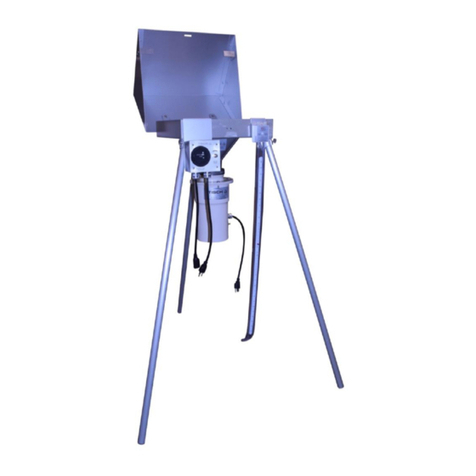
Tisch Environmental
Tisch Environmental TE-5200 Operation manual
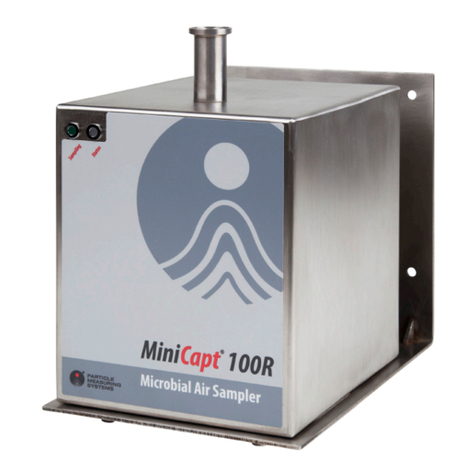
Particle Measuring Systems
Particle Measuring Systems MiniCapt 100R Operation manual
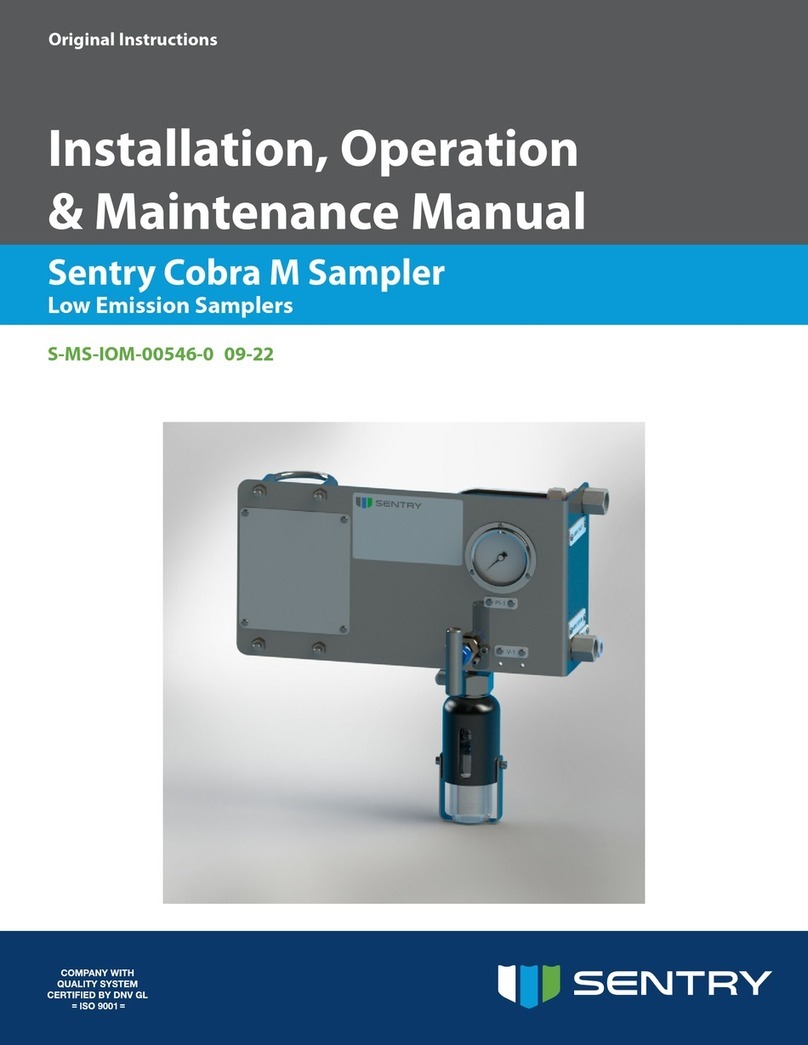
Sentry
Sentry Cobra M Installation, operation & maintenance manual

SYSMEX
SYSMEX SA-90 Instructions for use
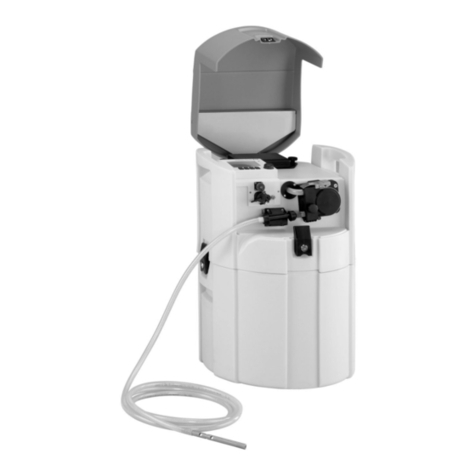
Endress+Hauser
Endress+Hauser Liquiport CSP44 Brief operating instructions
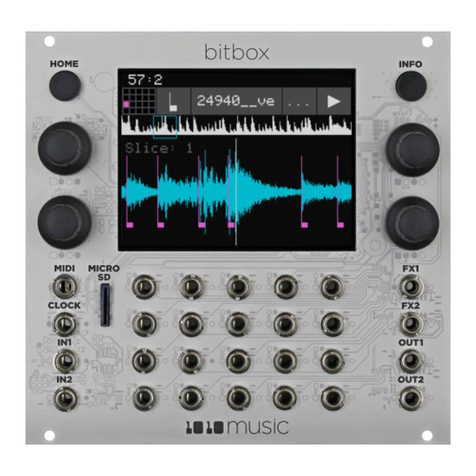
1010music
1010music Bitbox 3.0 user manual